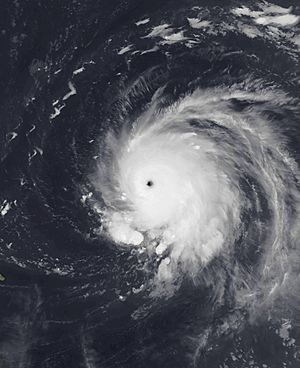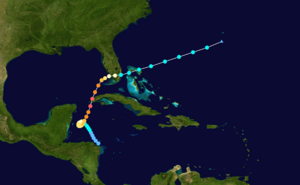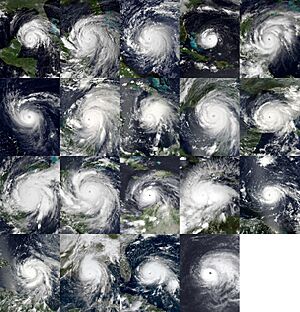List of Category 5 Atlantic hurricanes facts for kids

A Category 5 Atlantic hurricane is the strongest type of storm that forms in the Atlantic Ocean. These powerful storms have winds blowing at least 252 kilometers per hour (157 miles per hour). They are measured using the Saffir–Simpson hurricane wind scale.
Experts believe 11 Category 5 hurricanes happened between 1851 and 1959. However, it was harder to track storms back then because we didn't have satellites. Since 1960, 29 Atlantic hurricanes have reached Category 5 strength.
What is a Category 5 Hurricane?
In the Atlantic Ocean, hurricanes are watched by the National Hurricane Center (NHC) in the United States. Other weather groups, like Météo-France and the Met Office, also keep an eye on these storms.
A Category 5 hurricane is a tropical cyclone with very strong winds. These winds blow at 252 kilometers per hour (157 miles per hour) or faster. This speed is measured 10 meters (33 feet) above the ground.
So far, 40 tropical cyclones have been strong enough to be called Category 5 hurricanes. The first one officially recorded was in 1924. Before 1924, it was hard to measure the strongest winds. This is because tools like anemometers (which measure wind speed) were often broken during big storms. For example, during the Great Beaufort Hurricane of 1879, the wind measuring device was blown away.
Scientists are still looking at old weather data. They might change the strength of some past hurricanes. For instance, the 1825 Santa Ana hurricane might have been a Category 5 storm. Researchers also study old sediments (like dirt and sand) to find signs of powerful hurricanes from long ago. They found proof of a "giant hurricane" in Belize that was much stronger than Hurricane Hattie (a Category 5 storm) and hit before the year 1500.
Hurricane Records and Facts

The years 2000 to 2009 had the most Category 5 hurricanes, with eight of them. Before that, the 1930s and 1960s each had six. The year 2005 had the most Category 5 hurricanes in a single season, with four. Also, from 2016 to 2019, there was at least one Category 5 hurricane every year for four years in a row.
Some hurricanes have reached Category 5 strength more than once. This means they got very strong, then weakened, and then became a Category 5 again. Hurricanes like Camille, Andrew, Dean, Felix, Irma, and Maria each reached Category 5 twice. Allen, Isabel, and Ivan became Category 5 storms three times.
The 1932 Cuba hurricane spent the longest time as a Category 5 hurricane. However, this was before satellites, so it's harder to be sure. Irma holds the record for staying a Category 5 for the longest time in the satellite era.
Most Category 5 Atlantic hurricanes happen in September. This is when the Atlantic hurricane season is usually at its busiest. These September storms often get strong in the Gulf of Mexico, the Caribbean, or the open Atlantic. Many of them are Cape Verde hurricanes, which grow powerful as they travel over warm ocean waters.
Hurricanes that reach Category 5 in October and November usually get their strength in the western Caribbean. This area has warm waters and weather patterns that help storms grow strong late in the season.
List of Category 5 Atlantic Hurricanes
| Name | Dates at Category 5 intensity |
Duration at Category 5 intensity |
Peak intensity | Areas affected | Damage (USD) |
Deaths | Refs | |
|---|---|---|---|---|---|---|---|---|
| Wind speed | Pressure | |||||||
| "Cuba" | October 19, 1924 | 12 hours | 165 mph (270 km/h) | 910 hPa (26.87 inHg) | Central America, Mexico, Cuba Florida, The Bahamas |
90 | ||
| "San Felipe II Okeechobee" |
September 13–14, 1928 | 12 hours | 160 mph (260 km/h) | 929 hPa (27.43 inHg) | Lesser Antilles, The Bahamas United States East Coast, Atlantic Canada |
$100 million | 4,000 | |
| "Bahamas" | September 5–6, 1932 | 1 day | 160 mph (260 km/h) | 921 hPa (27.20 inHg) | The Bahamas, Northeastern United States | 16 | ||
| "Camagüey" | November 5–8, 1932 | 3 days 6 hours | 175 mph (280 km/h) | 915 hPa (27.02 inHg) | Lesser Antilles, Jamaica, Cayman Islands Cuba, The Bahamas, Bermuda |
$40 million | 3,103 | |
| "Cuba–Brownsville" | August 30, 1933 | 12 hours | 160 mph (260 km/h) | 930 hPa (27.46 inHg) | The Bahamas, Cuba, Florida Texas, Tamaulipas |
$27.9 million | 179 | |
| "Tampico" | September 21, 1933 | 12 hours | 160 mph (260 km/h) | 929 hPa (27.43 inHg) | Jamaica, Yucatán Peninsula | $5 million | 184 | |
| "Labor Day" | September 3, 1935 | 18 hours | 185 mph (295 km/h) | 892 hPa (26.34 inHg) | The Bahamas, Florida, Georgia The Carolinas, Virginia |
408 | ||
| "New England" | September 19–20, 1938 | 18 hours | 160 mph (260 km/h) | 940 hPa (27.76 inHg) | Eastern United States, Southwestern Quebec | $306 million | 682 | |
| "Great Atlantic" | September 13, 1944 | 18 hours | 160 mph (260 km/h) | 918 hPa (27.11 inHg) | Eastern United States, Atlantic Canada | $100 million | 300 | |
| Carol | September 3, 1953 | 12 hours | 160 mph (260 km/h) | 929 hPa (27.43 inHg) | Bermuda, New England, Atlantic Canada | $2 million | 5 | |
| Janet | September 27–28, 1955 | 18 hours | 175 mph (280 km/h) | 914 hPa (26.99 inHg) | Lesser Antilles, Central America | $65.8 million | 1,023 | |
| Esther | September 17, 1961 | 18 hours | 160 mph (260 km/h) | 919 hPa (27.14 inHg) | East Coast of the United States | $6 million | 7 | |
| Hattie | October 31, 1961 | 6 hours | 165 mph (270 km/h) | 914 hPa (26.99 inHg) | Central America | $60.3 million | 319 | |
| Inez | September 28–29, 1966 | 1 day | 165 mph (270 km/h) | 927 hPa (27.37 inHg) | Greater Antilles, Florida, Mexico | $229 million | 756 | |
| Beulah | September 20, 1967 | 6 hours | 160 mph (260 km/h) | 921 hPa (27.20 inHg) | The Caribbean, Mexico, Texas | $208 million | 59 | |
| Camille | August 16–18, 1969 | 1 day 6 hours | 175 mph (280 km/h) | 900 hPa (26.58 inHg) | Cuba, United States Gulf Coast | $1.42 billion | 259 | |
| Edith | September 9, 1971 | 6 hours | 160 mph (260 km/h) | 943 hPa (27.85 inHg) | The Caribbean, Central America Mexico, United States Gulf Coast |
$25.4 million | 37 | |
| Anita | September 2, 1977 | 12 hours | 175 mph (280 km/h) | 926 hPa (27.34 inHg) | Mexico | Unknown | 11 | |
| David | August 30–31, 1979 | 1 day 18 hours | 175 mph (280 km/h) | 924 hPa (27.29 inHg) | The Caribbean, United States East coast | $1.54 billion | 2,068 | |
| Allen | August 5–9, 1980 | 3 days | 190 mph (305 km/h) | 899 hPa (26.55 inHg) | The Caribbean, Yucatán Peninsula Mexico, South Texas |
$1.57 billion | 269 | |
| Gilbert | September 13–14, 1988 | 1 day | 185 mph (295 km/h) | 888 hPa (26.22 inHg) | Jamaica, Venezuela, Central America Hispaniola, Mexico |
$2.98 billion | 318 | |
| Hugo | September 15, 1989 | 6 hours | 160 mph (260 km/h) | 918 hPa (27.11 inHg) | The Caribbean, United States East Coast | $10 billion | 107 | |
| Andrew | August 23–24, 1992 | 16 hours | 175 mph (280 km/h) | 922 hPa (27.23 inHg) | The Bahamas, Florida, United States Gulf Coast | $26.5 billion | 65 | |
| Mitch | October 26–28, 1998 | 1 day 18 hours | 180 mph (285 km/h) | 905 hPa (26.72 inHg) | Central America, Yucatán Peninsula, South Florida | $6.08 billion | 11,374 | |
| Isabel | September 11–14, 2003 | 1 day 18 hours | 165 mph (270 km/h) | 915 hPa (27.02 inHg) | Greater Antilles, Bahamas Eastern United States, Ontario |
$5.37 billion | 51 | |
| Ivan | September 9–14, 2004 | 2 days 12 hours | 165 mph (270 km/h) | 910 hPa (26.87 inHg) | The Caribbean, Venezuela, United States Gulf Coast | $23.3 billion | 124 | |
| Emily | July 16, 2005 | 6 hours | 160 mph (260 km/h) | 929 hPa (27.43 inHg) | Windward Islands, Jamaica, Mexico, Texas | $1.01 billion | 17 | |
| Katrina | August 28–29, 2005 | 18 hours | 175 mph (280 km/h) | 902 hPa (26.64 inHg) | Bahamas, United States Gulf Coast | $125 billion | 1,836 | |
| Rita | September 21–22, 2005 | 1 day | 180 mph (285 km/h) | 895 hPa (26.43 inHg) | Cuba, United States Gulf Coast | $12 billion | 125 | |
| Wilma | October 19, 2005 | 18 hours | 185 mph (295 km/h) | 882 hPa (26.05 inHg) | Greater Antilles, Central America, Florida | $29.4 billion | 87 | |
| Dean | August 18–21, 2007 | 1 day | 175 mph (280 km/h) | 905 hPa (26.72 inHg) | The Caribbean, Central America | $1.76 billion | 45 | |
| Felix | September 3–4, 2007 | 1 day | 175 mph (280 km/h) | 929 hPa (27.43 inHg) | Nicaragua, Honduras | $720 million | 133 | |
| Matthew | October 1, 2016 | 12 hours | 165 mph (270 km/h) | 934 hPa (27.58 inHg) | Antilles, Venezuela, Colombia United States East Coast, Atlantic Canada |
$15.1 billion | 603 | |
| Irma | September 5–9, 2017 | 3 days | 180 mph (285 km/h) | 914 hPa (26.99 inHg) | Cape Verde, The Caribbean, Virgin Islands Cuba, Florida |
$64.8 billion | 138 | |
| Maria | September 18–20, 2017 | 1 day 4 hours 15 minutes |
175 mph (280 km/h) | 908 hPa (26.81 inHg) | Lesser Antilles, Virgin Islands, Puerto Rico Dominican Republic, Turks and Caicos Islands |
$91.4 billion | 3,018 | |
| Michael | October 10, 2018 | 30 minutes | 160 mph (260 km/h) | 919 hPa (27.14 inHg) | Central America, United States Gulf Coast | $25.1 billion | 74 | |
| Dorian | September 1–2, 2019 | 1 day 6 hours | 185 mph (295 km/h) | 910 hPa (26.87 inHg) | The Caribbean, The Bahamas United States East Coast, Atlantic Canada, Greenland |
$5 billion | 84 | |
| Lorenzo | September 29, 2019 | 3 hours | 160 mph (260 km/h) | 925 hPa (27.32 inHg) | Cabo Verde, Azores, Western Europe | $367 million | 20 | |
| Ian | September 28, 2022 | 6 hours | 160 mph (260 km/h) | 937 hPa (27.67 inHg) | Caribbean, Cuba, Florida, The Carolinas | $113 billion | 160 | |
| Lee | September 8, 2023 | 6 hours | 165 mph (270 km/h) | 926 hPa (27.34 inHg) | Bermuda, New England, Atlantic Canada | $50 million | 4 | |



